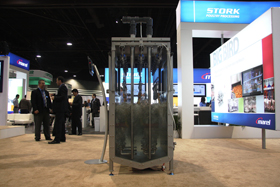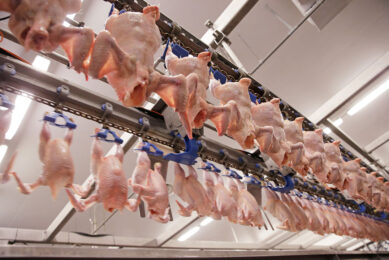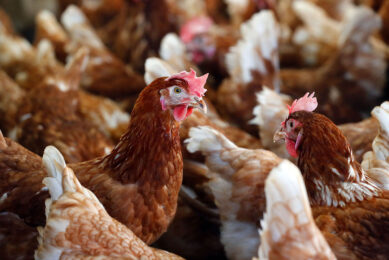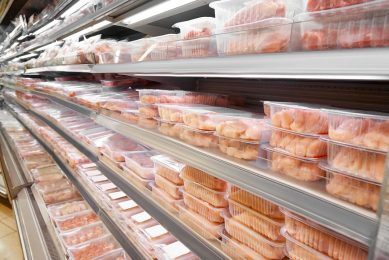IPE Atlanta: Focus on efficiency and product quality

The annual International Poultry Exposition (IPE) in Atlanta, Georgia, USA is usually the place for seeing new trends and products in poultry processing. This years’ show was no exception, with the focus this time on efficiency and product quality, and not forgetting animal welfare issues.
By Dr Roel Mulder, Spelderholt Poultry, Epe, the Netherlands
Major companies in the field of processing, showed their latest developments at IPE in Atlanta last January. In the recent past developments on scalding and stunning of broilers and chilling of carcasses were important.
Aspects of animal welfare, hygiene and food safety, water and energy saving, dominated in the design of equipment which should now be able to process over 12,000 broilers per hour on one line.
Stunning of poultry has been a major topic over recent years. In practice one can make a choice between the electrical and controlled atmosphere stunning methods in a large variety of designs. Electrical stunning, using a waterbath has become the favourite method, although nowadays the method is more and more criticised because of concerns regarding bird welfare. Over the past years several alternative methods have been proposed, but none have reached the stage of implementation in actual practice.
The low atmospheric pressure system (LAPS) of TechnoCatch, operating under practical conditions, seems to be a future alternative. TechnoCatch organised a series of lectures with regard to their low atmospheric pressure system, a patented method to achieve an irreversible stun in poultry. The process requires no unloading, handling or shackling without gas or electrical shock. The system has several advantages compared to other controlled atmospheric stunning systems. For the employees the system creates a better working environment, the final product shows less blood spots and an improved microbiological and meat quality.
End product quality
Marel-Stork demonstrated their solution for optimisation of the scalding process. Making use of the optimum heat transfer and a minimum use of energy, an efficient process can be ensured. The result is a better quality end product. Chilling of carcasses plays an important role in food safety, but also is important in energy and water saving practices. Air chilling is a good alternative towards immersion chilling. It minimises cross-contamination, protects natural flavour and it results in higher yields and a prolonged shelf life of the products, whether sold as whole carcasses or as portions.
Marel-Stork demonstrated their solution for optimisation of the scalding process. Making use of the optimum heat transfer and a minimum use of energy, an efficient process can be ensured. The result is a better quality end product. Chilling of carcasses plays an important role in food safety, but also is important in energy and water saving practices. Air chilling is a good alternative towards immersion chilling. It minimises cross-contamination, protects natural flavour and it results in higher yields and a prolonged shelf life of the products, whether sold as whole carcasses or as portions.
At the show amongst others, Morris & Associates showed traditional equipment with new technology: the high side/high flow Auger Poultry chiller, with IntraGrill technology allows water circulation in the tank in three ways, for a more efficient heat transfer. The ‘Combi in-line air chilling system’ of TopKip, significantly reduces water and energy costs as well, and this results in a longer shelf life of the products and additionally allows 100% tracing and tracking of individual carcasses, which nowadays is an increasingly important quality aspect.
Efficiency of operation
Cryogenic freezing and chilling is the area of Praxair. On the show the diced product chilling in combination with their new ultra performance flighted freezer was shown. This system which ensures precise temperature control, results in a lower evaporative loss to achieve maximum yield and quality of the products.
Cryogenic freezing and chilling is the area of Praxair. On the show the diced product chilling in combination with their new ultra performance flighted freezer was shown. This system which ensures precise temperature control, results in a lower evaporative loss to achieve maximum yield and quality of the products.
Also this year trends for a complete, controllable slaughtering process were visible. The use of sensors, cameras and robots will contribute to the efficiency of operation and will have a positive effect on the quality of the products. Software used for process control also allows full traceability. Several companies, for example Smart Motion Robotics and Italproject, showed their packaging solutions to reduce labour costs through use of their robots. Heat and Control showed their new multi-spectrum metal detector, which cannot be disturbed by false signals due to the moisture and salt content of the products tested.
The new DSI portioning system of JBT Food Tech combines vertical waterjet portioning technology with horizontal slicing for three-dimensional portioning. The system scans incoming meat and the improved software determines the most profitable use of the meat.
Correct cooking parameters
Further processed products as batter and breaded, grilled, marinated and roasted products have become more important. For every product specific procedures are needed with regard to the cooking process, in terms of yield, browning, texture and juiciness. Equipment should be flexible in managing the temperature, the air speed and relative humidity in the ovens.
Further processed products as batter and breaded, grilled, marinated and roasted products have become more important. For every product specific procedures are needed with regard to the cooking process, in terms of yield, browning, texture and juiciness. Equipment should be flexible in managing the temperature, the air speed and relative humidity in the ovens.
All products should be cooked to be safe, have a uniform quality and a high yield. Generally speaking the equipment for this type of products has improved considerably over the last years and all major companies have contributed, in order to give the possibility for using the correct cooking parameters to achieve optimum yield, quality and safety.













